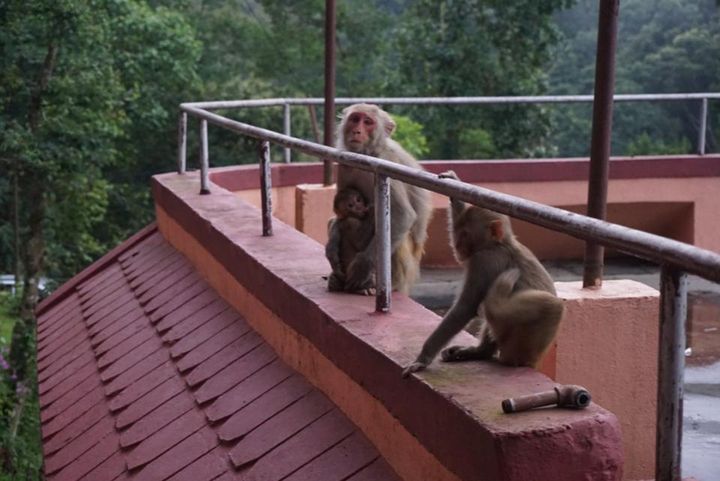It’s 5:30 a.m. I roll out of bed with an audible grunt, slip into my mandatory maroon robe, and wash up before heading down to the main meditation room. I could hardly believe myself: after two months of fast-paced couch-surfing around Europe for the first leg of my project to circumnavigate the globe through my social network, my idea of taking a break was waking up at the crack of dawn to meditate in the middle of the Nepalese mountains. A little extreme? Yes. But, I was burning out, and if I didn’t temporarily pause my travels, my mind and body exhaustion would force me to.
So here I was, sitting on a cold, wooden floor at a Dynamic Meditation class, my scarf tightly wrapped around me to shield me from the morning chill. We began the class with silence, followed by bowing and chanting of a popular Buddhist mantra. And then, just like that, everyone began to… scream.
That’s right. A room full of people wearing red robes at 6 a.m. in the morning began to scream at the top of their lungs. Initially horrifying? Yes. Was there some logic to it? Oh, yes.
Before I scare you, let me back up a bit and explain how I got there. I was originally planning to attend a Vipassana retreat, which is a well-known meditation practice that requires people to sit in utter silence for up to 16 hours a day without exercise, movement, writing, reading, or any other type of mental or physical stimulation. This was a little aggressive for me, mostly because I had a lot of work to do and didn't want to abstain from writing. Another option soon presented itself: my host’s cousin happened to work at a Dynamic Meditation center, and although I had never heard of the practice before, I decided to give it a try.
Sitting in a room full of strangers screaming at the top of their lungs, I began to question my decision. It didn’t exactly make it better when, after ten minutes of shrill screaming, everyone began to gently sway to the sound of Hindi music as if that hadn’t just happened.
My initial experience with Dynamic Meditation was admittedly shocking, but dare I say I left the retreat with a lot of inspiration and an uplifted spirit? Believe it or not, it had amazing effects on me: I came away with a newfound learning for different meditation techniques, a refreshed mindset, and a lot of new article material (case in point).
Here is what I learned about the Dynamic Meditation practice, the key takeaways we can take away from it for everyday life, and what I personally came away with.

Dynamic Meditation Explained
While many people are familiar with Vipassana (a popular technique that focuses on complete silence and mindfulness of breathing), Dynamic Meditation is still relatively unknown in the West.
I’d like to disclaimer that the philosophy behind Dynamic Meditation was explained to me by the Sannyasin (the guru disciples who live and work at the center) who I interviewed – I am by no means an expert in this meditation technique, and can only reiterate what I learned and was taught during my time there.
According to Indian guru Osho, who established the Dynamic Meditation practice, meditation techniques involving silent sitting were designed for a different human – one that lived thousands of years ago, was much simpler, and likely did manual work all day. Modern humans, however, are not capable of sitting still in silence the way our ancestors were. Today's human is predominantly sedentary in everyday work life and has a very short attention span that is split across multiple tasks at any given moment.
Dynamic Meditation is based on the belief that modern man needs to be continuously aware, conscious and alert to meditate. Specifically, the meditation is a "fast, intense and thorough way to break old, ingrained patterns in the body-mind that keep one imprisoned in the past, and to experience the freedom, the witnessing, silence and peace that are hidden behind these prison walls." Meditation sessions at the center are therefore designed to release tension with specific physical activities that generate a feeling of catharsis. The first exercise of the day is divided into five stages:
- After bowing and chanting a mantra, there are ten minutes of very heavy, fast, nasal breathing that is designed to disrupt the buffer between the conscious and unconscious (i.e. you focus so much on breathing heavily that you can’t think about anything else).
- Then comes the intimidating part: consciously going "mad" for ten minutes straight to release any sort of internal tension that has accumulated. This includes screaming, jumping, crying, kicking, laughing - whatever you need to let go of what you're keeping inside (on my first day, I screamed about the center’s terrible Wi-Fi service because I honestly did not know what else to do).
- Ten minutes is spent jumping up and down chanting "Hoo! Hoo! Hoo!" (yes, really).
- For fifteen minutes, you freeze in whatever position you were in and stay there silently and aware of your body.
- The last fifteen minutes are for celebration: that is, dancing to traditional Hindu music.
This meditation session, as well as the others that were taught throughout the retreat, are meant to create a safe zone for meditators to air out frustrations. As my teacher explained, these techniques are designed to unload our repressed emotions and generate high amounts of energy that we can then harness and channel into our meditative practice. In short, exuding all of this energy makes it possible to sit quietly and focus on meditation.

Why It’s Important To Air Out Frustrations
Although meditation retreats like these aren’t everyone’s cup of tea, there were some interesting insights that I found applicable to everyday life.
The vast majority of us live in a society where we are constantly being constrained by rules and norms. While some are designed for the general population’s safety and well-being, a good amount is outdated and even nonsensical. From the moment we are born, we are prescribed how to behave and what to do in order to become a successful member of society. We are expected to be a good student, worker, child, friend, parent, etc. We are told that we need to attend a decent college, pursue a well-paying career, get married, buy a house, and so on, in order to be successful, contributing members of society.
The thing is, this cookie-cutter prescription doesn’t work for everyone. It certainly doesn’t work for me. I can personally relate to this construct because I, too, have been hammered with expectations for how to achieve the American Dream since I came to the U.S., and I simply don’t buy it. I don’t believe that working crazy hours at a desk job, having two weeks of vacation a year, and solely using promotions and titles as benchmarks to success are the answers to producing value in society or creating good work, which is why I'm proving otherwise by being a digital nomad. That desk life is not for everybody – yet we are made to believe otherwise.
What I found interesting about Dynamic Meditation is that it is specifically designed to provide people with catharsis. We have a lot of tension and repression built up from having to play by society’s rules, and that has to come out somehow. With high-energy activities such as heavy breathing, screaming, and dancing, we have the option of expelling our internal frustrations in a safe and healthy manner.
It’s probably not the best idea to scream at the top of your lungs in your apartment at 6 in the morning, and that’s not what I’m suggesting. My takeaway was that it’s important for us to find activities in our daily lives that can help us release the tension that we accumulate from everyday work and life stress. Perhaps you love playing an instrument, hiking, or drawing. Whatever your interests, it’s important to cultivate them in order to stay happy, healthy, and creative.
I asked one of the Sannyasin how dancing a few hours every day would help me with meditation. Her answer was beautiful: dancing, she said, is one of the few activities that come from the heart. When she dances, her heart opens and the outside world disappears.
Which made me wonder, what opens my heart?

The Results
After some thinking – which, funnily enough, was facilitated by meditation – I decided that what opens my heart is consistently meeting inspiring people, learning about different cultures, and being constantly stimulated by new environments. In other words, it is travel. That’s what deeply inspires my work and put me on the path to becoming a digital nomad.
I suppose that my traveling around the world is in and of itself a form of meditation. It’s what I love to do, what releases my frustrations, and what keeps me sharp and creative in my work. Maybe we don’t have to scream and dance to air out our frustrations. Perhaps what we need to consistently do is just something that we love, whether that is our day job or a hobby.
As much as Dynamic Meditation initially shocked me, one thing is certain: the week I spent giving myself a break at the meditation center completely relaxed my mind and reconnected me to my priorities. Not to mention, it made me very efficient at my work during my time there and for weeks thereafter. I was writing nonstop every day – words were just flowing out of me. I’d be at one of the sessions dancing, and sentences would naturally pop into my mind and dance along with me. Whether I believed in the practice or the guru was irrelevant. Clearly, just the act of doing something for my well-being was working.
Although I don’t think I’ll be regularly practicing Dynamic Meditation, my time at the retreat taught me two valuable lessons: 1. We have to be diligent with taking care of ourselves so that we don’t become too stressed or burn out, and 2. although there are many approaches to do so, it’s crucial that whatever we choose comes from the heart.
A few days before I had to leave the retreat, I turned to the same Sannyasin who had counseled me about the practice when I got there and asked in complete and utter frustration why I hadn’t yet figured out how to open my heart through dance. She asked me what I was thinking about. I said, “well, dancing, obviously.”
She told me to forget about the act of dancing and instead focus on what truly makes me happy. So I thought about travel, everything I was learning from being a digital nomad, and all the amazing memories I was making.
And, just like that, it worked.
I started dancing like no one was watching.
Celinne Da Costa is a brand identity coach, writer, and traveler sharing stories of humanity, life design, and self-discovery. Follow her journey on CelinneDaCosta.com and @CelinneDaCosta.
